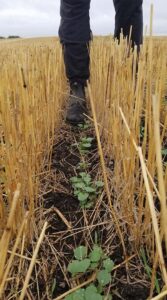After the drought: Top 10 preparations for 2022
- Assess the soil nutrient situation
Short, thin, low-yielding crops use fewer nutrients, so soil nutrient reserves should be higher than usual after the 2021 growing season. This should reduce fertilizer application rates for 2022. A fall soil test will give a good assessment of available nutrients. November timing can work if probes can get in the ground. The 4R article on page 29 has more soil sampling tips.
- Preserve those residual nutrients
Weeds growing after harvest can use residual nutrients that the crop didn’t. Fall weed control can stop that take up before it starts to cause major loss of that residual resource. November is probably too late for fall weed control, because effective control requires good growing conditions and healthy, living plants. So the focus turns to weeds emerging in the spring before the crop. The good news is that nutrients will be returned to the soil as weeds decompose, but these nutrients may not be available – or fully available – for the 2022 crop.
- Keep standing stubble to improve moisture situation
Before doing that pre-winter tillage or harrowing, consider this: Stubble traps more snow, increasing potential soil moisture next spring. Phillip Harder, scientist with the Centre for Hydrology at the University of Saskatchewan, says stubble “drastically reduces” sublimation of the snowpack in the middle of winter. Sublimation is the conversion of water from the snow (solid) to vapour phase, bypassing the intermediate liquid stage. The first main mechanism for sublimation on the Canadian Prairies happens when solar radiation drives the phase change from solid to gas, then dry warm air absorbs the water vapour and wind blows it away. The second happens during blowing snow events where snow particles that get suspended in the windy and turbulent air mass are very efficiently sublimated into the airmass. Harder says sublimation is most intense in windy and open areas where chinooks are common. It is less extreme in areas with more bush and without chinooks.
 Stubble traps more snow, increasing potential soil moisture next spring.
Stubble traps more snow, increasing potential soil moisture next spring.
- Assess subsoil moisture heading into winter
What is the water situation in your fields? How much recharge occurred with late-season rain? A basic moisture probe is half-inch diameter metal rod with a 5/8-inch ball bearing on the business end and a crossbar handle on top. Push the ball end into the soil as far as you can without twisting it. It will only penetrate to the depth of moist soil, stopping when it hits a region of dry soil or a stone. Read “How to use a moisture probe” at canolawatch.org. For a more modern approach, some weather stations have soil probes that measure moisture down to one metre, and providing a yield estimate in the process. For more on these, read the January 2019 article “Probe of Possibilities” at canoladigest.ca.
- Choose cultivars that produce well under stress
Farmers may have noticed that some canola hybrids performed better than others in 2021. Were the reasons management related, or could cultivar traits be a factor? Researchers have shown genetic differences for heat tolerance and drought tolerance, and these differences may show up in on-farm experiences or in cultivar comparison trials. Check on trial results from various sources, including the grower-funded Canola Performance Trials at canolaperformancetrials.ca. When available, seeding date, seeding rate, seeding tool and other agronomic management practices may be helpful for context. When consulting trial results to choose hybrids to grow next year, local replicated data is the best data.

- Is winter canola an option?
Not really. Past attempts at growing winter-types were not successful. Winter survival is low, and spring frost survival is even lower, in Western Canada. Will this change as winters get milder? Maybe. But good luck in predicting winter and spring temperatures. Even though there are a few winter cultivars registered in Canada, these are targeted for use in Ontario. Cultivars from the United States are not registered in Canada. Until winter and spring frost hardiness is improved dramatically, winter canola will not fit in Western Canada.
- Learn to identify verticillium stripe
Verticillium stripe is one disease that can be severe in hot, dry conditions. Did you observe verticillium symptoms in 2021? High disease severity situations are rare but can result in yield losses. As research continues on this disease here in Canada, clearer management options will be identified to help minimize the spread of this disease and keep disease severity low. This is something to look for in 2022. Find more on verticillium, including scouting and management, in the Diseases section at canolaencyclopedia.ca.
- Prepare for more insects in 2022
Many insects thrive in dry conditions, especially flea beetles, lygus and grasshoppers. The experience in 2021 could set up us for high insect pressure in 2022. High flea beetle numbers in the fall are not a reliable indicator of issues next year, but pre-planning could include higher seeding rates to compensate for expected flea beetle feeding and upgraded seed treatments. Examine any factors that might impact crop establishment next year – especially residue management and seed bed preparation – for potential improvements. Seeding shallow (half to one inch depth) with a fine-tuned level seeder into a warm, moist seedbed will help with rapid emergence, which improves canola competition against flea beetles. Agronomy Insight in the September 2021 Canola Digest has more detailed tips to improve flea beetle management. Find the article at canoladigest.ca.
- Expect some herbicide carryover after 2021
Residual herbicides need (1) soil moisture at the surface, (2) warm soil temperatures and (3) time for breakdown to occur as expected. Areas with very low moisture accumulation through June, July and August will be at highest risk for herbicide carryover into next year. Consider this when making cropping decisions. Please reach out to herbicide manufacturers for rotational details on all products applied in 2021 on fields planned for canola in 2022.
- Sign up for Canola Watch
Canola Watch provides timely agronomy updates from the Canola Council of Canada agronomy specialists, with input from extension specialists, researchers and provincial canola organization staff. The weekly email helps with scouting tips and management practices. Sign up at canolawatch.org. The Canola Watch website also has past articles, mini quizzes, the Canola Watch podcast, and a place for you to send us your questions.
Good crop establishment will benefit from some winter planning as described in this Top 10 list. Next spring, avoid spring practices that can dry out the seedbed. Get the drill ready to seed shallow and uniformly. Keep fertilizer out of the seed row, especially if plants are already stressed. Slow down if necessary to improve seed placement. These are good practices every year, and especially in a dry year. Hopefully we’re working from a position of strength in 2022.





